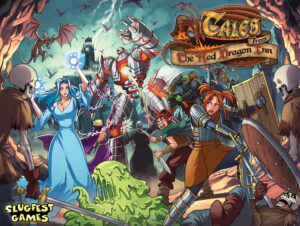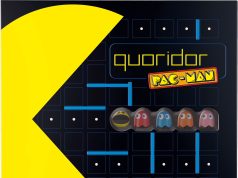 Ok. I am one and done with my break from cooperative fantasy games. Thank you, River of Gold!
Ok. I am one and done with my break from cooperative fantasy games. Thank you, River of Gold!
As a reminder, I recently reviewed a fantasy boss battler, Kinfire Chronicles: Night’s Fall, to which I gave a glowing 4.5 stars.
This was followed up with another 4.5 star review with the fantasy adventure game Euthia: Torment of Resurrection.
It is now time for a fantasy dungeon crawler. I present to you Tales from the Red Dragon Inn!
Tales from the Red Dragon Inn is set in the Red Dragon Inn universe, created by Slugfest Games. Previous games were centered around the titular inn and the shenanigans between adventurers after they have returned from questing. This game focuses on the actual dungeon crawling.
Did Tales from the Red Dragon Inn continue the streak of great fantasy games I have reviewed this year? Or are the Tales simply drunken boasts that do not live up to the hype?
NOTE: This will be a spoiler-free review
Gameplay Overview:
Tales from the Red Dragon Inn is a cooperative fantasy dungeon crawler for one to four players. It is also a campaign game, with 25 scenarios split across five chapters. Each scenario lasts between an hour and 90 minutes with two players, increasing up to two hours with higher player counts and/or scenario complexity.

Each scenario has its own win and loss conditions. The round structure is split across three phases; however, each scenario might have steps unique to that scenario. The basic round structure is as follows:
- Ready Phase
- Invigorate abilities – remove one cooldown token from your abilities
- Roll scheme dice – this roll determines the AI for each monster grouping for the round
- Fill the initiative bag – put Hero and monster tokens in the bag
- Combat Phase
- Draw and resolve initiative – Pull and resolve the initiative token, with that player/monster taking its turn
- Objective Phase
- Check objectives and win conditions
Rounds are repeated until either the win or loss condition is met.

Game Experience:
What made me want to slay more monsters and drink more mead
My favorite aspect of Tales From the Red Dragon Inn is its streamlined combat. Slugfest clearly wanted to focus on the fun of a dungeon crawl. Most importantly, every attack hits. No whiffs. No frustration. You attack, you hit. You may not DAMAGE the enemy due to Toughness or Shield tokens, but you will at least remove those tokens, creating a damage opportunity for your companions.
Combat dice can explode as well. Roll a crit, and you can roll another die. I love exploding dice in my games! Oh, and do you hate determining line of sight? No worries. It has been replaced with Line of Fire. Simply count the spaces. Is your enemy behind a wall, but still within your range of four spaces? BAM! You hit them. Movement is easy as well. Spaces that are difficult or impassable are clearly marked on the map. Finally, monsters are easy to control. Each map includes the monsters you will face and their respective AI. You roll dice during the Ready Phase that will determine how each group of monsters will behave. This allows you to plan for the upcoming round, assuming their initiative is not chosen before yours…

While this does simplify combat, Epic Dice adds a level of strategy that is also extremely satisfying. You will earn Epic Dice by rolling Inspire icons which are added to a communal pool. These dice can be added to any attack to empower that attack or to prevent damage. Discussing when to use these dice, as well as how many, really adds to the cooperative experience. We managed to take down a boss in one round due to utilizing these dice, combined with lucky critical roles.
I also love the characters and their powers. While the six characters are the typical rogue, fighter (two of them), mage (again, two of them), and cleric, each plays differently. Every character has three basic actions (a move, an attack, and invigorate, which expedites cooldowns). In addition, they have wildly different Hero cards. Some have charges, some have cooldowns, and others have reactions. These abilities really open up the table discussion. Should you use your hard-hitting cooldown ability now, or save it for the boss? Can you take out that enemy so I can move over past where they were. One of our favorite combos was having Eve (mage), summon an illusion next to an enemy, allowing Gerki (rogue) to trigger the backstab bonus on his attack.

That brings us to the campaign. Again, Slugfest wanted to focus on the fun of gaming, and not the bookkeeping. When characters advance, EVERY character receives their advancements, not just those that participated in the scenario. Why? So, you can change characters at any time and there is no level difference. Sick of being a mage? Switch to Zog. A friend has joined you who hasn’t played before. Give them one of the characters of their choice. Each character has a power tree that adds additional tokens to spend to improve aspects of your game, including your attack or reducing incoming damage. The power tree is reset after every scenario. This allows different customization for every scenario. As for the campaign itself, it is focused. There are no branching paths. You follow the story, complete scenarios, unlock some cards, and repeat. While it is simple, I embrace this simplicity. Aeon’s Trespass (deep combat) and Agemonia (deep narrative) have their purpose. When I just want to play cooperatively with friends, roll dice, kill monsters, and follow a decent story, I play this game.
Finally, the game is a breeze to set up and easy to teach. Every scenario is self-contained on a preprinted map sheet. I personally loved the use of preprinted maps which are also kept in a map folder to help prevent additional wear. Learning the game is done through three rulebooks. A walkthrough is used for the first chapter. You will be forced flip between the walkthrough and Chapter 1 scenario book. While it is a pain at first, you will quickly absorb the details you need from the walkthrough while learning as you play through chapter one. After chapter one, you can rely on the scenario book, while utilizing the reference manual for specific keyword questions, as well as appendices for attacking and monster movement, among others.
What made me want to go back to playing River of Gold:
My least favorite mechanism in a dungeon crawler is an initiative bag. It can make the game way too swingy. Ever had the joy of pulling only enemy activations at the end of a round and then having the same thing happen at the start of the next round? Unfortunately, that mechanism is included in this game. I would have preferred a set initiative system where player and enemy powers can move participants earlier or later in the turn order.

One of the big reasons to play dungeon crawlers is for character advancement and growth. I was slightly disappointed in the advancement and the loot in this game. Advancement only happens at the end of a chapter when new cards are unlocked from the vault. That means you will play five to six scenarios before improving your character’s powers. I wish the power increase was drip-fed through all scenarios instead of at the completion of a chapter.
As for loot, you will unlock new items after every scenario; however, the problem is not the loot. It is how much you can equip. There are three item types available and, for the most part, you are limited to equipping one of each type. As the game progresses, you will find your vault overflowing with items while each character is still only utilizing three of them. For a game that leaned hard into crazy situations and powers, I found the strict item limits a strange design choice.
Finally, there is no fail forward. If you lose, the game tells you to replay the scenario again. I am not a fan of replaying scenarios. I want to experience the game, not have to spend an hour redoing a scenario I just lost due to a terrible initiative draw. I wish there was built-in fail forward for the game. For review purposes, this one may have been house ruled…
Final Thoughts:
When I first heard of Tales from the Red Dragon Inn, I dismissed it. I did not enjoy the Red Dragon Inn games and assumed this was a simple dungeon crawler using characters from that IP. Then I heard the praise being heaped on the game from multiple sources. Fine… I guess I’ll try it. Well, I am sure glad I gave the game a chance!
I was surprised at how well-developed the game was, especially the fun and engaging combat, the unique players and powers, and the overall campaign. This game focuses on the fun of a dungeon crawler. I highly recommend Tales from the Red Dragon Inn to dungeon crawl enthusiasts. More importantly, I would recommend this to those who hesitate to play dungeon crawlers and/or campaign games. It may open your eyes to a new genre you can enjoy!
Final Score: 4 Stars – An excellent fantasy dungeon crawler that focuses on fun
 Hits:
Hits:
• Streamlined combat
• Epic Dice
• Fun characters and powers
• Excellent campaign
• Easy setup and easy to teach
Misses:
• Initiative bag
• Advancement is slow
• Loot limitations
• No fail forward





















